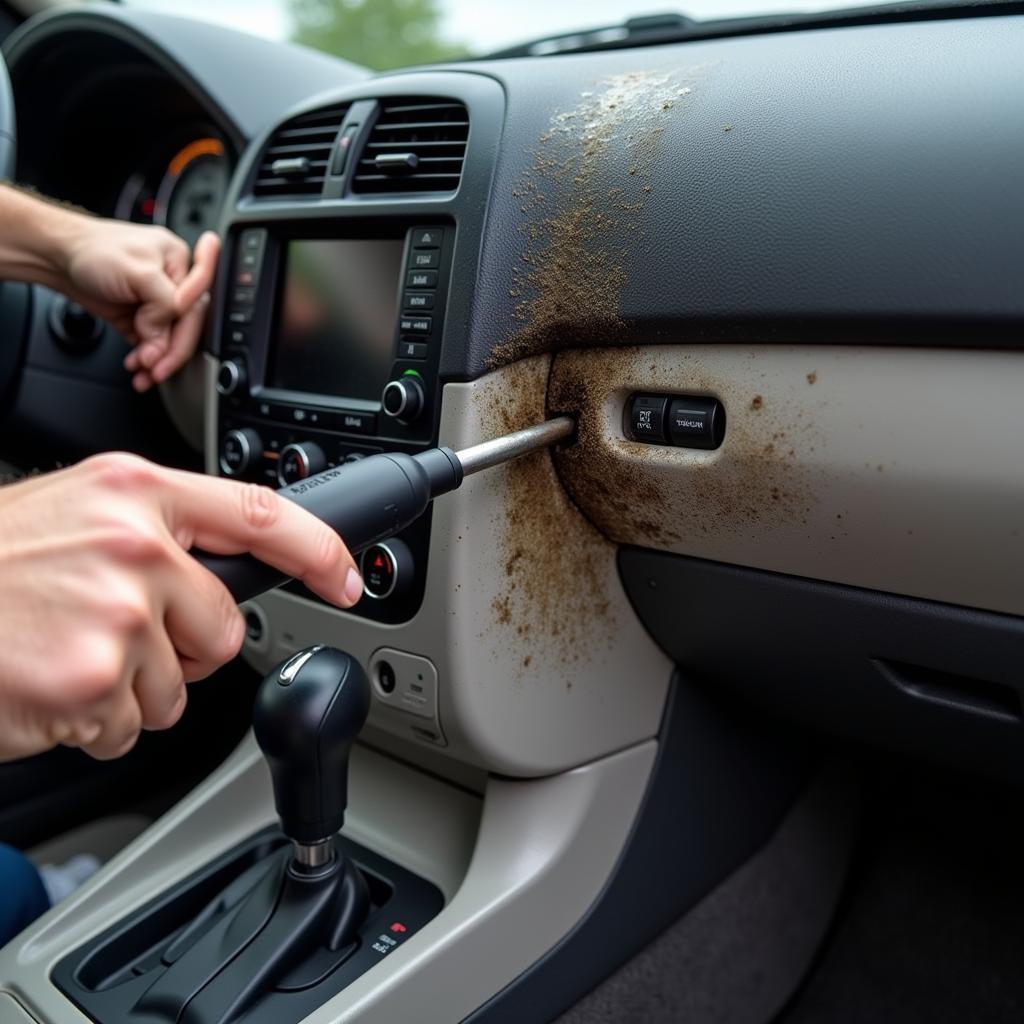Dealing with a broken AC unit in your car can make those summer drives unbearably hot. While it might seem daunting, troubleshooting and even fixing some car AC issues is possible with the right knowledge. This guide will walk you through common car AC problems, how to diagnose them, and potential solutions to get your car cool again.
Understanding Your Car’s AC System
Before diving into fixes, it’s helpful to understand the basic components of your car’s AC system:
- Compressor: This is the heart of the system, compressing and circulating refrigerant.
- Condenser: Located at the front of your vehicle, the condenser cools the refrigerant, changing it from a gas to a high-pressure liquid.
- Evaporator: Positioned inside the dashboard, the evaporator converts the liquid refrigerant back into a gas, absorbing heat from the cabin air.
- Receiver/Drier: This component stores refrigerant and removes moisture.
- Expansion Valve/Orifice Tube: This regulates the flow of refrigerant into the evaporator.
Common Car AC Problems and Solutions
1. AC Blows Warm Air
This is often the first sign of trouble. Here’s what might be wrong:
- Low Refrigerant: The most common culprit. A leak in the system can cause refrigerant to escape.
- Solution: Have the system inspected for leaks and recharged by a professional.
- Faulty Compressor: A failing compressor won’t be able to circulate refrigerant properly.
- Solution: Compressor replacement can be costly. Consult a mechanic to diagnose and discuss options.
2. AC Makes Noises
Unusual sounds are a clear indication something’s amiss:
- Hissing or Bubbling: This usually points to a refrigerant leak.
- Solution: Locate and repair the leak, then recharge the system.
- Clicking or Clunking: Could be a sign of a failing compressor or a problem with the AC clutch.
- Solution: Have the compressor and clutch inspected by a mechanic.
- Squealing: This often indicates a worn-out serpentine belt, which powers the AC compressor.
- Solution: Replace the serpentine belt.
3. Weak Airflow
If your AC is running but the airflow is weak, consider these possibilities:
- Clogged Cabin Air Filter: A dirty filter restricts airflow.
- Solution: Replace the cabin air filter. This is a simple DIY task.
- Blower Motor Issue: A failing blower motor won’t be able to push air effectively.
- Solution: The blower motor may need to be repaired or replaced.
4. AC Smells Bad
Foul odors coming from your AC vents are unpleasant and potentially indicate serious issues:
- Musty Smell: This usually means mold or mildew has accumulated in the evaporator case.
- Solution: Have the evaporator case cleaned and disinfected.
- Gas Smell: This could signal a refrigerant leak, which can be dangerous.
- Solution: Immediately turn off your AC and have the system inspected for leaks by a professional. For more information on addressing a gas smell, you can check out this guide: [how to fix gas smell from ac vent car](https://autotippro.com/how to fix gas smell from ac vent car/).
 Cleaning a Car AC Evaporator
Cleaning a Car AC Evaporator
DIY vs. Professional Repair
While some AC problems can be tackled by handy car owners, others require specialized tools and expertise. Here’s a quick guide:
DIY-Friendly Fixes:
- Replacing the cabin air filter
- Recharging the AC system (with the proper equipment and safety precautions)
Best Left to Professionals:
- Repairing refrigerant leaks
- Replacing the compressor, condenser, or other major components
- Diagnosing complex electrical issues
“Trying to fix a refrigerant leak yourself can be dangerous and environmentally harmful. Always consult a certified technician for these types of repairs,” advises John Miller, a seasoned automotive HVAC specialist at Miller’s Auto Repair.
Preventing Future AC Problems
Taking preventative measures can save you headaches and costly repairs down the line:
- Regular AC Service: Have your AC system inspected and serviced annually, preferably in the spring.
- Run Your AC Regularly: Even during cooler months, run your AC for a few minutes every couple of weeks to keep the refrigerant circulating and prevent seals from drying out.
- Keep it Clean: Regularly clean debris from the front of your vehicle’s condenser to ensure proper airflow.
Conclusion
Don’t suffer through another scorching summer with a broken AC. By understanding common problems and following these tips, you’ll be well-equipped to diagnose issues and get your car’s AC back to keeping you cool. If you’re in the San Antonio area and need assistance with your car AC, don’t hesitate to contact the experts at AutoTipPro. You can reach us at +1 (641) 206-8880 or visit our office at 500 N St Mary’s St, San Antonio, TX 78205, United States.
FAQs
1. How often should I recharge my car’s AC?
Ideally, you shouldn’t need to recharge your AC system frequently. If you’re consistently low on refrigerant, it usually indicates a leak that needs to be repaired.
2. How much does it cost to fix a car AC leak?
The cost of repair depends on the location and severity of the leak. It could range from a few hundred dollars to over a thousand for major component replacement.
3. Can I use a DIY AC recharge kit?
While DIY kits are available, it’s generally recommended to have your AC recharged by a professional. Overcharging the system can cause damage.
4. How can I tell if my AC compressor is bad?
Signs of a failing compressor include loud noises (clunking, clicking), warm air blowing from the vents even when the AC is on, and a noticeable decrease in cooling performance.
5. Why is my car AC blowing cold then warm air intermittently?
This issue could be caused by a few things, including a low refrigerant charge, a faulty expansion valve, or a problem with the AC control system. It’s best to have a mechanic diagnose the problem.





Leave a Reply